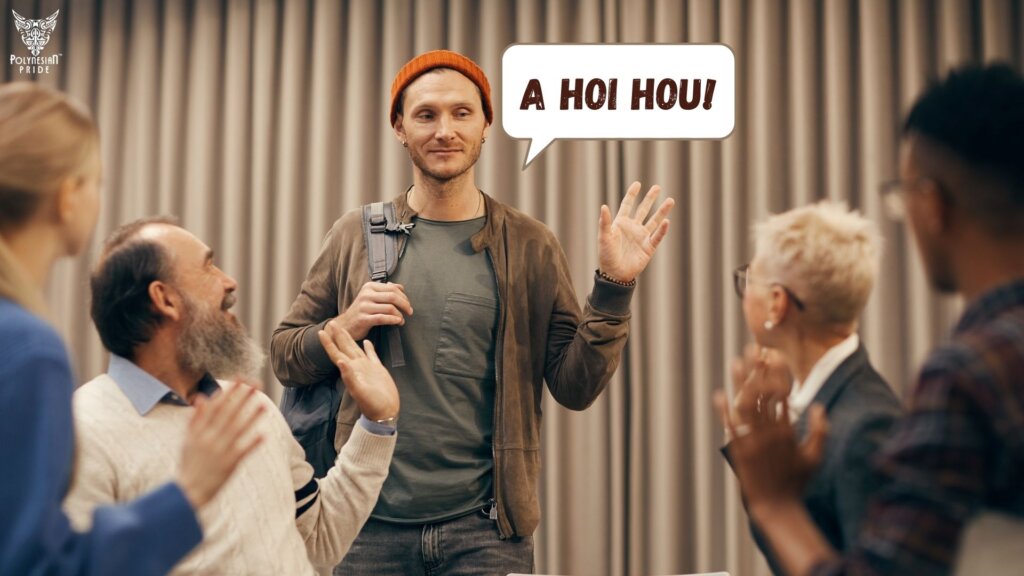13+ Phrases in Hawaiian Greetings You Must Know Before Visiting Hawaii

Have you ever felt the warmth of a greeting that meant more than just a hello? In Hawaii, every greeting carries the spirit of Aloha – a unique blend of love, respect, and connection. Whether planning a visit to the islands, learning Hawaiian, or simply curious about the language, understanding these greetings is a powerful way to connect with Hawaii’s rich culture.
From the universal aloha to heartfelt farewells like a hui hou (until we meet again), Hawaiian greetings offer a deeper way to engage with the people and traditions of the islands.
This guide will explore essential Hawaiian greetings, their cultural significance, and how to use them respectfully and accurately.
The Deeper Meaning of Aloha: More Than a Greeting
At its core, Aloha is one of the most well-known Hawaiian greetings, but it is much more than a simple “hello” or “goodbye”. Aloha carries layers of meaning, often representing love, compassion, and harmony. It’s not just a word but a way of life that reflects the interconnectedness of all people and nature in Hawaii.
- Pronunciation: Aloha is pronounced (ah-LOH-ha).
- Uses: As a greeting, aloha can be used to say “hello” and “goodbye”. However, it expresses love, peace, and a general sense of caring for others.
The “aloha spirit” is deeply ingrained in Hawaiian culture. It reflects how Hawaiians approach life – with kindness, unity, and respect. When you say aloha in Hawaii, it’s more than just a word; it’s a recognition of shared humanity. Embracing aloha means embracing the ideals of harmony, patience, and respect for others.

Top 13 Hawaiian Greetings for Visitors
If you’re planning a trip to Hawaii, learning basic Hawaiian greetings is a simple way to show respect for the local culture. Here are some of the most important greetings you should know:
1. Aloha – Hello
Pronunciation: (a-lo-ha)
Meaning: More than just “hello,” aloha signifies love, kindness, compassion, and peace. It reflects a deep cultural philosophy of harmony in Hawaii.
2. Mahalo – Thank You
Pronunciation: (mah-hah-loh)
Usage: Use mahalo to express gratitude. For “thank you very much”, say mahalo nui loa (mah-hah-loh noo-ee). Mahalo is commonly heard in day-to-day interactions, from restaurants to shops.
3. ‘A’ole Pilikia – You’re Welcome/No Problem
Pronunciation: (ah-oh-leh pee-lee-kee-yah)
Context: This phrase is often used in response to mahalo, letting the speaker know their thanks are accepted with no trouble or inconvenience.
4. A Hui Hou – Until We Meet Again
Pronunciation: (ah-hoo-wee-ho-oo-uu)
Usage: A heartfelt farewell, much like “see you soon”. It is often said at the end of gatherings with the hope of future reunions.

5. Howzit? – How Are You?
Pronunciation: (how-zit)
Context: A casual greeting commonly used in Hawaii. It’s a quick way to ask, “How are you?” or “What’s up?” in a friendly manner.
6. Honu – Green Sea Turtle
Pronunciation: (hoe-new)
Note: The honu is a green sea turtle often seen in Hawaiian waters and holds cultural significance in local legends and daily life. You’ll frequently encounter them while snorkeling.
7. ‘Ono Grinds – Delicious Food
Pronunciation: (oh-no grinds)
Usage: A fun and local way to compliment food, particularly when discussing a satisfying Hawaiian meal.

8. Waina – Wine
Pronunciation: (wy-nah)
Context: This word is useful for ordering or discussing wine, including the local wines produced in Hawaii.
9. Poke – Poke Seafood Bowl
Pronunciation: (poh-keh)
Note: Poke is a beloved dish in Hawaii, made with diced raw seafood (often tuna) and commonly served as an appetizer or light meal.
10. Komo Mai – Welcome
Pronunciation: (eh koh-moh-my)
Meaning: A warm greeting that conveys an invitation to enter or join, representing the spirit of hospitality and community.

11. A ‘O Ia! – There You Have It!
Pronunciation: (ah-oy-yah)
Usage: A phrase used to cheer on performers or fellow travelers during events. It’s a lively way to celebrate a completed task or performance.
12. Shoots
Meaning: “Yes”, “for sure”, or “alright”.
Example: “You guys like to go surfing? Shoots!”
13. Brah
Meaning: Short for “brad-dah”, a casual way of addressing someone, similar to “bro”.
Example: “Brah, pass me the shoyu”.

Language is just one part of Hawaiian identity. If you’re also curious about Native Hawaiian appearance and heritage, check out our guide on what Hawaiians look like.
Casual Hawaiian Slang and Expressions
In addition to formal greetings, Hawaiians often use casual slang that reflects the laid-back lifestyle of the islands. Here are some common expressions you might hear:
1. Bumbai
Meaning: Later or otherwise.
Example: Bumbai we go beach.
2. Broke Da Mouth
Meaning: Used to describe delicious food.
Example: This shave ice so ʻono, broke da mouth kine.
3. Chicken Skin
Meaning: Goosebumps.
Example: My cousin can sing so good, gimme all kine chicken skin.
4. Choke
Meaning: A lot.
Example: Was choke people at the park today, brah.
6. Hana Hou – Encore!
Meaning: To do again, often used to ask for an encore performance.
Example: Hana hou! Hana hou!

7. Holo Holo
Meaning: To go for a leisurely drive or adventure.
Example: My cousins and I always go ‘holo holo’ on the weekends.
8. Kamaʻāina
Pronunciation: (ka-muh-ai-nah)
Meaning: A local or native-born person.
Example: Kamaʻāina gets discounts at some stores.
9. Da Kine
Meaning: A phrase that can mean just about anything, depending on the context.
Example: You know da kine? They came over yesterday.
10. Kanak Attack
Meaning: The feeling of sleepiness after eating a big meal.
Example: Brah, that food was so ono, I get one kanak attack.
11. Slippahs
Meaning: Slippers (flip-flops).
Example: Make sure you take off your slippahs before going inside.

12. Mo’ Bettah
Meaning: More better.
Example: This place gets mo’ bettah sushi than da one down the street.
13. No Moa
Meaning: No more.
Example: Sorry, brah, we no moa dat kine flavor.
14. No Ack
Meaning: Stop showing off or being arrogant.
Example: No ack like you da best surfer.
15. Ni’ele
Pronunciation: (nee-eh-leh)
Meaning: Nosy.
Example: No be ni’ele or you goin’ get it.

These additional phrases will help you understand and participate in Hawaiian culture on a deeper level, beyond the formal greetings. Whether you’re enjoying local food or hanging out with friends, these casual expressions bring a bit of local flavor to everyday conversations.
The Importance of Pronunciation
The correct pronunciation is key to using Hawaiian greetings respectfully. Hawaiian is a musical language with only 13 letters (five vowels and eight consonants, including the ʻokina, a glottal stop). Learning how to say words ensures you honor the language and culture.
Vowel Sounds
Hawaiian vowels are pronounced slightly differently than in English:
- A: (ah) as in “father”.
- E: (eh) as in “met”.
- I: (ee) as in “see”.
- O: (oh) as in “no”.
- U: (oo) as in “blue”.
The ʻokina is a pause or break in the word, similar to the sound in “uh-oh”.
Practice Makes Perfect
If you need help pronouncing a word, ask locals for help. Most Hawaiians will appreciate your effort to learn their language and will gladly guide you on correct pronunciation. Showing respect by learning the language can open doors to deeper conversations and connections.

The Cultural Significance of Hawaiian Greetings
Hawaiian greetings go beyond simple phrases – they are deeply connected to the island’s values of respect, community, and love. When you use greetings in Hawaiian, like aloha, you’re embracing a tradition that honors the interconnectedness of people and nature. Every Hawaii greeting reflects this spirit of connection, whether welcoming someone warmly or bidding farewell with hope.
Aloha and Ohana
In Hawaiian culture, ohana (family) extends beyond blood relatives to friends and community. When you greet someone with aloha, you acknowledge them as part of your extended family, or ohana. This greeting, central to the greetings in the Hawaiian language, carries more than a literal meaning. It reflects love, kindness, and compassion, which are vital parts of daily life in Hawaii.
A Hui Hou: Hope in Farewells
The phrase a hui hou – “until we meet again” – captures the Hawaiian belief that goodbyes are never final. This greeting in Hawaiian expresses the hope that people will cross paths again, whether in one life or another. ‘A hui hou’ used in everything from casual farewells to more solemn occasions like funerals, embodies optimism and the enduring nature of relationships. These greetings in the Hawaiian language reflect Hawaii’s view that bonds are unbreakable and that connections will always find a way to endure.
In every greeting, Hawaiians emphasize respect and togetherness, key values that have shaped the island culture for centuries.

Hawaiian Greetings in Occasions
In Hawaii, greetings play an important role in casual and formal gatherings. Whether attending a traditional luau, a wedding, or a cultural festival, Hawaiian greetings like aloha and e komo mai can deepen your connection and show respect for the culture.
Weddings and Formal Events
At weddings, aloha and a hui hou are often used in speeches to welcome guests and bid farewell with love and warmth. The phrase E Komo Mai invites guests to feel at home and be part of the celebration.
Funerals and Farewells
In more somber settings, such as funerals, a hui hou is comforting to say goodbye, expressing the hope of reunion beyond this life. These greetings in such events reinforce their emotional and cultural depth.

How to Use Hawaiian Greetings Respectfully
While learning Hawaiian greetings is a great way to show respect for the culture, using them appropriately and thoughtfully is important.
- Always try to pronounce Hawaiian words correctly. Listen carefully to locals or ask for guidance if you need more clarification.
- Use greetings like aloha and mahalo in the appropriate context, and understand their deeper meanings.
- Remember that Hawaiian greetings carry cultural significance. They reflect community, love, and connection values, so they should be used sincerely.

CONCLUSION
Hawaiian greetings are much more than words – they are an invitation to connect with Hawaii’s people, culture, and traditions. Whether you’re a visitor looking to engage with the local community, a language learner diving deeper into Hawaiian culture, or simply someone curious about the islands, using greetings like aloha and a hui hou will enrich your experience.
The next time you greet someone in Hawaii, remember that you’re not just saying “hello” or “goodbye” – you’re sharing the spirit of aloha, a reminder of the love, respect, and connections that bind us all.
FAQs About Hawaiian Greetings
Q: What is a typical Hawaiian greeting?
A: The most common Hawaiian greeting is aloha. It’s widely used to say “hello” and “goodbye,” but aloha holds deeper meanings beyond a simple greeting. The word encompasses love, kindness, compassion, and peace, reflecting the spirit of Hawaiian culture and values. When you greet someone with aloha, you acknowledge them and offer them warmth and respect.
Q: How do Hawaiians greet each other?
A: One traditional Hawaiian greeting is the honi ihu, which involves touching noses. This practice allows two people – a man and woman, two men or two women – to exchange their breath, known as ha, considered the life force in Hawaiian culture. By sharing breath, individuals convey mutual respect and form a bond, as breath represents life and vitality. The honi ihu also allows people to share scents, further emphasizing closeness and connection, symbolizing unity and the spirit of aloha.
Q: How do greetings in Hawaiian language?
A: To greet someone in Hawaiian, you can use “Aloha” for both “hello” and “goodbye.” For “welcome,” say “E Komo Mai,” and to ask “How are you?” use “Pehea ‘oe?”. These greetings reflect the warmth and connection of Hawaiian culture.
How do Hawaiians ask, “How are you?”
Hawaiians say “Pehea ‘oe?” which means “How are you?” It’s a common greeting that shows concern for the well-being of others.
What is the Hawaiian phrase for “thank you”?
The Hawaiian phrase for “thank you” is “Mahalo”. To express deeper gratitude, you can say “Mahalo nui loa,” meaning “thank you very much.”

I am Leilani Miller – I research focusing on Vanuatu – volcanic landscapes, blue holes, coral reefs & rainforests. I have over five years of experience researching and sharing insights on tourism and environmental activism. Explore and experience without limits through my latest article.
Contact information:
Email: [email protected]
Tel: +1 (808) 555-1528






